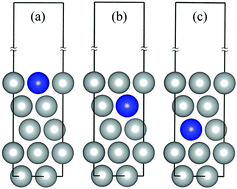Understanding the surface segregation behavior of transition metals on Ni(111): a first-principles study
Abstract
The surface composition of an alloying system has an important impact on its catalytic and chemical properties. The segregation behavior of 3d, 4d and 5d transition metals on an Ni(111) surface has been investigated by performing first-principles calculations in the framework of density-functional theory with the generalized gradient approximation for the exchange–correlation functional. Our calculated surface segregation energies are in good agreement with the experimental data as well as with previous calculated results. Most importantly, we have made an attempt to correlate the surface segregation behavior with the surface energy difference between the alloying (solute) metal and the host metal, the elastic energy release, and the heat of solution of the alloying metal in the host metal. By doing so, we not only overcome the difficulties that empirical models encounter, but also clearly identify the importance of each contribution to the segregation behavior of an alloying metal. The present study provides valuable insight into the surface segregation behavior of solute atoms in alloying systems.


 Please wait while we load your content...
Please wait while we load your content...